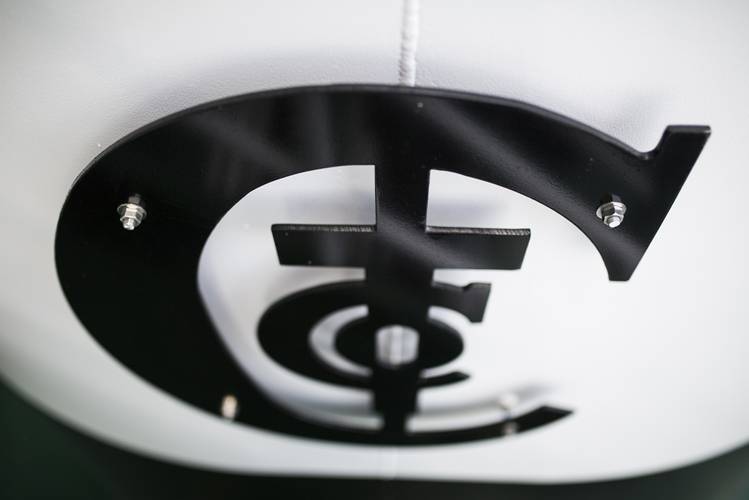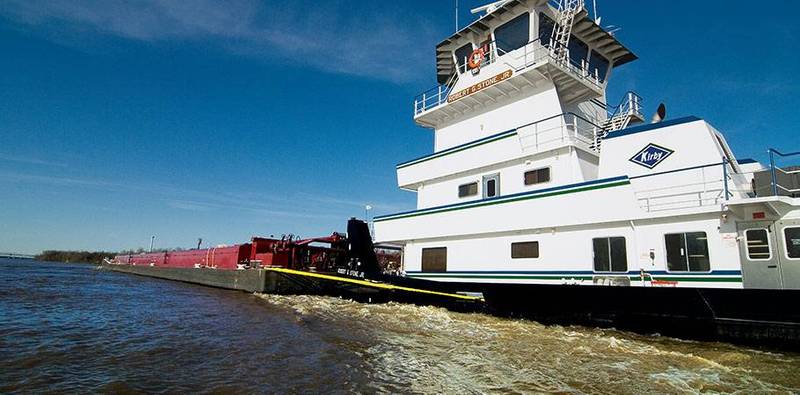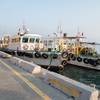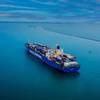Kirby Announces 2018 Q4/FY18 Results, Deal to Buy Cenac's Marine Fleet
Kirby Corporation announced a net loss attributable to Kirby for the fourth quarter ended December 31, 2018 of ($24.4) million, or ($0.41) per share, compared with earnings of $231.3 million, or $3.87 per share, for the 2017 fourth quarter. Excluding certain one-time charges, 2018 fourth quarter net earnings attributable to Kirby were $44.9 million, or $0.75 per share. Consolidated revenues for the 2018 fourth quarter were $721.5 million compared with $708.1 million reported for the 2017 fourth quarter.
For the 2018 full year, Kirby reported net earnings attributable to Kirby of $78.5 million or $1.31 per share, compared with $313.2 million, or $5.62 per share for 2017. Excluding certain one-time charges, 2018 net earnings attributable to Kirby were $171.4 million, or $2.86 per share. Consolidated revenues for 2018 were $2.97 billion compared with $2.21 billion for 2017.
Kirby also announced the signing of a definitive agreement to acquire the marine transportation fleet of Cenac Marine Services, L.L.C. (“Cenac”) for approximately $244 million in cash, subject to certain closing adjustments. The purchase will be financed through additional borrowings. Cenac’s fleet consists of 63 30,000-barrel inland tank barges with approximately 1.9 million barrels of capacity, 34 inland towboats, and 2 offshore tugboats. Cenac moves petrochemicals, refined products, and black oil, including crude oil, residual fuels, feedstocks and lubricants on the lower Mississippi River, its tributaries, and Gulf Intracoastal Waterway for major oil companies and refineries. The closing of the acquisition is expected to occur late in the first quarter of 2019 and is subject to customary closing conditions, including regulatory approvals under the Hart-Scott-Rodino Act.
David Grzebinski, Kirby’s President and Chief Executive Officer, commented, “While our quarter’s financial results were negatively impacted by one-time impairment charges in our coastal and Osprey barge businesses, the underlying results from operations were solid. Excluding the non-cash impairment charges, our earnings per share of $0.75 compares to our guidance range of $0.55 to $0.75.
“In inland marine transportation, we continued to experience strong demand and high barge utilization levels. These favorable market conditions resulted in further pricing increases with spot market rates sequentially improving in the mid-to high single digit range. During the quarter, we experienced a 28% increase in delay days as a result of seasonal weather patterns along the Gulf Coast and lock delays which reduced operating efficiencies. Despite those challenges, inland marine delivered a slight increase in sequential revenue with operating margins similar to the third quarter.
“The acquisition of Cenac’s young fleet of well-maintained inland tank barges and modern boats is an ideal complement to Kirby’s operations. Cenac has a strong history of operational excellence, and is well respected by the industry and its customers. Cenac’s inland fleet of 30,000-barrel tank barges, of which approximately 80% are clean and 20% are heated black oil vessels, has an average age of only four years. Similarly, Cenac’s fleet of modern inland towboats and offshore tugboats has an average age of only six years. The addition of these vessels to Kirby’s fleet will not only further reduce our average age profile, but will also further enable us to avoid significant capital outlays for new vessels in the future.
“In coastal, we continued to witness tightening market conditions and modest pricing improvement, particularly on large capacity vessels in the Atlantic region. As expected, however, our financial results in the quarter were negatively impacted by planned major shipyard maintenance on several large capacity vessels. Additionally, during the quarter we impaired four older articulated tank barge units (“ATBs”) and one leased barge that require mandatory ballast water treatment systems under new regulations. Investing to meet this requirement in these aging barges would be financially unattractive. We expect that we will early retire these ATBs at their next shipyard dates which range between 2020 and 2023.
“In our distribution and services segment, despite many vendor supply chain constraints in our pressure pumping manufacturing business, we reported a sequential 5% increase in segment revenue and an 18% increase in operating income. During the quarter, our manufacturing teams worked to resolve the supply chain issues and complete orders which ultimately resulted in a sequential increase in the number of new and remanufactured pressure pumping units delivered to our customers. Looking forward, while there is some market uncertainty regarding oil and gas activity, continued new orders have resulted in an overall increase to our manufacturing backlog which should provide for a sustained level of activity well into the second quarter of 2019,” Mr. Grzebinski concluded.
Segment Results – Marine Transportation
Marine transportation revenues for the 2018 fourth quarter were $382.5 million compared with $330.4 million for the 2017 fourth quarter. Operating income for the 2018 fourth quarter was $44.5 million compared with $28.6 million for the 2017 fourth quarter.
In the inland market, barge utilization was in the low to mid-90% range during the quarter and similar to the 2017 fourth quarter. Operating conditions were negatively impacted by lock closures in Louisiana as well as seasonal wind and fog along the Gulf Coast. Spot market pricing improved during the quarter, with rates increasing in the mid-to high single digit range sequentially and significantly year-over-year. Average term contract pricing on expiring 1-year contracts increased in the low to mid-single digits, but was offset by some multi-year contracts that renewed lower during the quarter. Revenues in the inland market increased approximately 20% compared to the 2017 fourth quarter primarily due to the contribution from the Higman acquisition, pressure barge acquisitions, improved pricing, and increased customer demand. The operating margin for the inland business was in the mid-to high teens during the quarter.
In the coastal market, barge utilization rates remained in the 80% range during the 2018 fourth quarter. Compared to the 2017 fourth quarter, spot market pricing was approximately 10% higher, and term contracts repriced modestly higher during the quarter. Revenues in the coastal market were up slightly year-on-year, primarily due to higher activity in the coal transportation business. During the quarter, the coastal operating margin was in the negative mid-single digits and was adversely impacted by planned major shipyard maintenance for several large capacity vessels.
The marine transportation segment’s 2018 fourth quarter operating margin was 11.6% compared with 8.6% for the 2017 fourth quarter which included $3.9 million of severance expense.
Segment Results – Distribution and Services
Distribution and services revenues for the 2018 fourth quarter were $339.0 million compared with $377.7 million for the 2017 fourth quarter. Operating income for the 2018 fourth quarter was $28.2 million compared with $34.5 million for the 2017 fourth quarter.
In the oil and gas market, revenues and operating income declined compared to the 2017 fourth quarter primarily due to reduced activity in the oilfield which resulted in lower customer demand for new and overhauled transmissions, parts and service. Although up sequentially, the manufacturing business reported lower year-on-year revenue and operating income as a result of reduced new pressure pumping unit and equipment deliveries. During the quarter, the oil and gas operating margin was in the high single digits.
In the commercial and industrial market, revenues and operating income increased compared to the 2017 fourth quarter primarily due to significant improvement in the commercial marine business. The recovery of the inland tank barge and dry cargo markets, as well as improved activity offshore market, resulted in increased demand for diesel engine service. Revenues and operating income in the power generation market declined primarily due to reduced year-on-year demand for stand-by power generation in the late months of hurricane season. During the quarter, the commercial and industrial operating margin was in the high single digits.
The distribution and services operating margin was 8.3% for the 2018 fourth quarter compared with 9.1% for the 2017 fourth quarter which included $1.6 million of severance expense. The reduced operating margin is primarily the result of a change in business mix.
Cash Generation
EBITDA of $124.5 million for the 2018 fourth quarter compares with EBITDA of $109.0 million for the 2017 fourth quarter. Cash flow was used to fund capital expenditures of $70.1 million during the 2018 fourth quarter, including $7.1 million for new inland towboat construction, $11.7 million for progress payments on the construction of six 5000 horsepower coastal ATB tugboats, $11.3 million for progress payments on the new 155,000 barrel coastal ATB under construction that delivered in the 2018 fourth quarter, and $40.0 million primarily for upgrades to existing inland and coastal fleets. During the 2018 fourth quarter, Kirby used $34.7 million in cash to purchase 27 inland barges from CGBM 100, LLC and three specialty barges and a towboat that were previously leased from a third party. Total debt as of December 31, 2018 was $1,410.2 million, and Kirby’s debt-to-capitalization ratio was 30.5%.
2019 Outlook
Commenting on the 2019 full year outlook and guidance, Mr. Grzebinski said, “Our earnings guidance range for the year is $3.25 to $3.75 per share, reflecting continued strength in inland activity with higher overall demand, improvement in coastal profitability, and a modest increase in revenue and operating income in distribution and services. This guidance range includes the Cenac acquisition, which we expect will be earnings neutral to slightly positive in 2019, taking into consideration integration costs, the time needed to integrate the fleet, inherited contract pricing, higher interest expense, and anticipated synergies. Overall, the midpoint of our guidance range reflects year-on-year earnings per share growth of more than 20% excluding one-time items in 2018.”
In the inland marine transportation market, 2019 guidance contemplates favorable market dynamics with continued growth in customer demand, driven by new petrochemical plants and pipelines from the Permian that will bring additional volumes to the Gulf Coast. These factors are expected to result in barge utilization rates in the low to mid-90% range during the year. Together with a full year of contribution from 2018 acquisitions, including Higman, Targa’s pressure barge business, and CGBM’s tank barges, as well as Cenac, inland revenues are expected to increase in the low to mid-double digits year-on-year with quarterly operating margins ranging in the mid-to-high teens.
In the coastal market, barge utilization is expected to improve into the low to mid-80% range, driven by stable to slightly improving customer demand and expected additional industry retirements of aging barges due to ballast water treatment regulations. Pricing is expected to increase modestly with low to mid-single digit improvement on most renewing term contracts and spot market rates as industry utilization improves. As a result, coastal revenues are expected to increase slightly year-on-year, and operating margins are expected to be breakeven to slightly positive during the year.
In the distribution and services segment, 2019 revenue and operating income are expected to be flat to up in the mid-single digits compared to 2018. In the oil and gas market, recent oil price volatility and uncertainty is expected to result in lower distribution sales and service of engines, transmissions and parts. In manufacturing, however, the current backlog for new and remanufactured pressure pumping units and equipment should provide stable activity levels through the first half of 2019. Continuing demand for pressure pumping unit remanufacturing and service, international projects, and efficient and environmentally friendly pressure pumping equipment is expected to continue into the second half of the year. In commercial and industrial, revenues and operating income are expected to increase with higher anticipated demand for back-up power systems and specialty equipment rentals. Activity in the nuclear back-up power generation market and the commercial marine markets is expected to be stable. Overall, operating margins in distribution and services are expected to be in the high single digits, with lower margins due to product mix being offset by additional cost synergies related to the integration of Stewart & Stevenson.
Kirby expects 2019 capital spending to be in the $225 to $245 million range, including the Cenac fleet. Capital spending guidance includes approximately $45 million in progress payments on new marine vessels, which includes three 5000 horsepower coastal tugboats and fifteen 2600 horsepower inland towboats. Approximately $155 to $165 million is associated with capital upgrades and improvements to existing inland and coastal marine equipment (including approximately $25 million for coastal ballast water treatment systems) and marine facility improvements. The balance of approximately $30 million largely relates to new machinery and equipment, rental fleet growth, facility improvements, and information technology projects in the distribution and services segment.
Mr. Grzebinski concluded, “2018 was an exciting year at Kirby, and I’m pleased with the hard work and performance of our team to deliver significant year-on-year growth in revenue and earnings per share, excluding one-time items. During the year, we closed several acquisitions in our marine transportation segment and made significant progress with the integration of Stewart & Stevenson. Our actions in 2018 have set the stage for continued growth in 2019. Our Inland marine fleet is in excellent condition, and we expect meaningful growth in its earnings. Coastal is expected to return to breakeven or slightly positive operating income. In distribution and services, the strength of our current manufacturing backlog is encouraging, and increasing demand for back-up power generation systems and our diversified portfolio should help mitigate potential headwinds. And finally, our strong balance sheet, together with meaningful growth in cash flow from operations and reduced capital expenditures will allow us to focus on debt reduction in 2019 while providing flexibility to pursue small acquisition opportunities.”
















